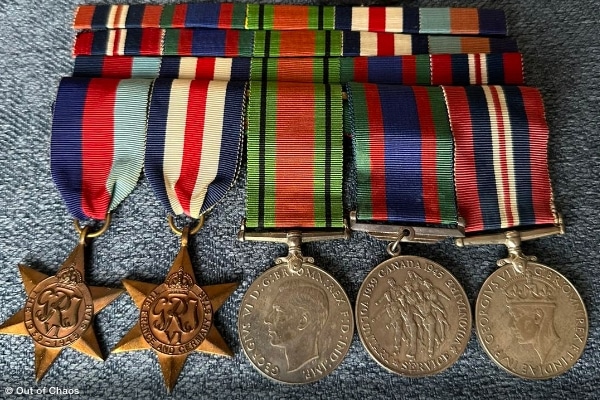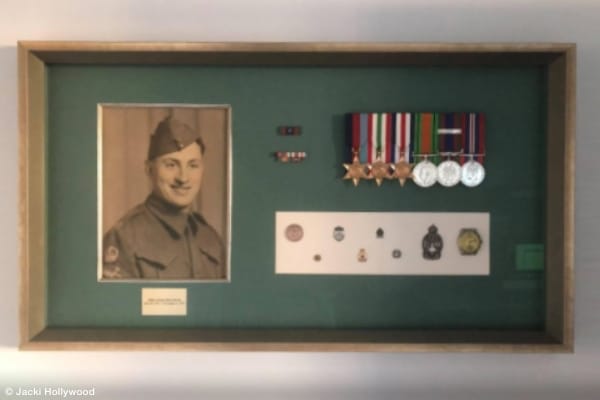
Last year, during an estate clearout, the Out of Chaos team found some military medals. We posted a few pictures of them on social media. Colleague Jacki Hollywood chimed in and identified the medals for us. This year, I thought it was fitting to have her write a guest post on organizing and downsizing military memorabilia.
Militaria
Military memorabilia, often called militaria, is a meaningful part of a military member’s personal history yet also part of Canadian history. It represents the sacrifices and achievements of those who served and continue to serve in the Canadian Armed Forces (CAF). Whether you inherit militaria or are a passionate collector, properly handling and preserving military memorabilia is essential to honour and maintain these artifacts’ historical significance. Militaria encompasses almost all aspects of military life, including:
- Medals and ribbons
- Uniforms, including rank insignia, buttons, lapel pins, etc.
- Hats, berets, and helmets
- Weapons (swords, bayonets, firearms)
- Inert Ordnance (empty shell casings, etc.)
- Equipment (compass, binoculars, canteen, etc.)
- Books and training manuals
- Flags and guidons
- Currency (both notes and coins)
- Identity badges and papers
- Certificates of completed training
- Maps, charts, and posters
- Journals, photographs, letters, and postcards (personal and professional)
- Postage stamps
- Invitations and programs to official military functions
Here are some best practices for dealing with militaria to ensure its preservation and personal and cultural value.
Research and Document
If you come across military memorabilia when you’re downsizing, it’s essential to do your research. You should understand the history and significance of each piece before deciding what to do with it. It is helpful to create a detailed document for each artifact and include its background, associated stories about it, and how it came to be in your possession. This information will enhance the collection’s value for historians and your family’s future generations.
If you’re lucky enough to talk to the original owner of the artifacts, record or document their stories. However, some objects may represent very powerful memories, so please respect the member/veteran if they choose not to share their stories.
In some cases, the military member may not want to deal with or keep their military items. But that doesn’t mean it should all go in the trash heap. Instead, determine the value and significance of the artifacts and consider where you might donate them. Here are a few places where you can find information.
Where to Find Information about Military Memorabilia
The Canadian Armed Forces Identity System: This site explains past and present ranks, badges, guidons, colours, dress manuals, etc. It will help you identify uniforms, accoutrements (patches and badges), flags, and standards.
Canadian Medals Chart: This site shows modern Canadian orders, decorations, and medals and the order in which they are worn. Veterans Canada explains historical medals dating back to 1866 and how to find military service records and attestation papers in the Library and Archives of Canada.
The Royal Canadian Legion: The Legion supports many veterans’ initiatives. Its members may be able to provide details about your treasures, including how they were used during military service and what those items meant to the military member. If they can’t help you directly, they may be able to point you in the right direction for information.
Museums and Historical Societies: Some museums and historical societies, even those in smaller towns, might be interested in militaria. They could provide some information about your items and how they relate to the local area’s history. For example, your uncle, who received the Meritorious Service Medal, may have been the only one in his county to get one.
Online Auctions: eBay is a great place to get an idea of the monetary value of your collection. There are also military-specific online auction sites, some dedicated to the military of specific countries or specific periods in history. Remember that the value generally increases when you have more history (provenance) about your artifact.
Collectors and Traders Groups: There are many military collector groups around the world. They hold shows and fairs where people can bring in their items for evaluation. Some members of these groups also provide virtual appraisals.
Antique Dealers and Appraisers: If you have visited some online auctions and feel that your pieces may be worth a lot of money, it is best to pay for a professional appraisal. You can check out our resources page or search for an appraiser near you. Remember to ask for references.
If you have foreign militaria, other nations and their armed forces have sections on their websites that deal specifically with their military history. These sites provide information about medals and decorations, uniforms, weapons, and even vehicles.
Handling and Cleaning
Military memorabilia can be fragile, especially if it’s old or seen combat. Handle items with clean hands. Some people wear cotton gloves to prevent oils and dirt from their skin from transferring onto the artifacts. Place militaria on a soft, clean surface to avoid damaging them.
I do not recommend cleaning military memorabilia yourself because you could damage it if you don’t know what you’re doing. Instead, consult archivists or preservation specialists for advice.
Preservation, Storage, and Display
It is important to preserve and/or display military memorabilia properly to ensure that it continues to honour the people who proudly served their country and can be passed from one generation to the next. Always store artifacts in a cool, dry place away from direct sunlight, extreme temperatures, and humidity. That means attics, basements, and garages are off-limits. Additionally, choose archival-quality boxes, tissue paper, and protective sleeves to prevent deterioration. These materials are more expensive than what you find in most office supply stores, but it is worth the cost to maintain the enduring value of your collection.
To display items like medals, certificates, and photos, consider framing them using archival-quality materials. For example, UV-protective glass prevents sunlight damage, and acid-free matting ensures the items don’t degrade over time. For large objects like uniforms and flags, enlist the help of framing professionals so as not to damage, warp, or stretch the fabric.
Respect the historical integrity of military memorabilia. Do not alter or modify items unless absolutely necessary. If you must make alterations, ensure they are reversible and do not compromise the authenticity. Consider consulting conservation professionals before making any repairs or adjustments.

Letting Go of Militaria
As Linda has often explained in her blog, you can’t keep everything. Sometimes, you must – and indeed should – let stuff go. Decluttering military memorabilia – specifically current militaria – isn’t as easy as dropping it in a charity bin. You must ensure that items such as uniforms, badges, rank insignia, and certain documents are returned to the Canadian Armed Forces or destroyed.
It’s sad to say, but we often hear about Stolen Valour. That’s when someone impersonates an armed forces member or claims another’s medals or honours as their own. It is disrespectful and illegal (Criminal Code of Canada, R.S.C., 1985, c. C-46, Section 419). For that reason, you should contact your local Regular or Reserve Forces unit, a cadet unit, or the Royal Canadian Legion. They should be able to provide resources on where to return or donate the items.
Consider donating letters, journals, and photos related to your historical memorabilia. This will contribute to the relevance and credibility. Large museums might not accept your donations, but other groups might be interested, such as:
- Local libraries and historical societies
- History departments or Military Studies departments of colleges and universities
- Community Centres
- Veterans’ groups
Many military units have their own museums and historical societies, so if you know which unit the member served in, ask them if they would accept the donation.
Re-enactment groups and theatre troupes may be interested in certain historical militaria. They may not take entire uniforms – especially those in rough condition, but the buttons and insignia might be helpful to them in re-creating period costumes.
A Note about Weapons
Many collections of military memorabilia contain weapons such as swords, knives, bayonets, and firearms. They may be antiques, but they can still be dangerous. In fact, some might now be illegal. Please seek out expert assistance when dealing with weapons – especially firearms.
If you choose to display swords, knives, and bayonets, consider investing in locked display cases with shatter-proof glass. Have a professional gunsmith deactivate firearms before storing them in a locked display cabinet.
If you decide to sell or donate these items, follow all laws and regulations for sale and transport.
Military memorabilia allows us to connect with the hardships and triumphs of those who served – in the past and present. By properly preserving these artifacts and treating them with care and respect, you contribute to the ongoing legacy of our military history. Additionally, you ensure that future generations can learn from and appreciate those willing to make the ultimate sacrifice for our country.
